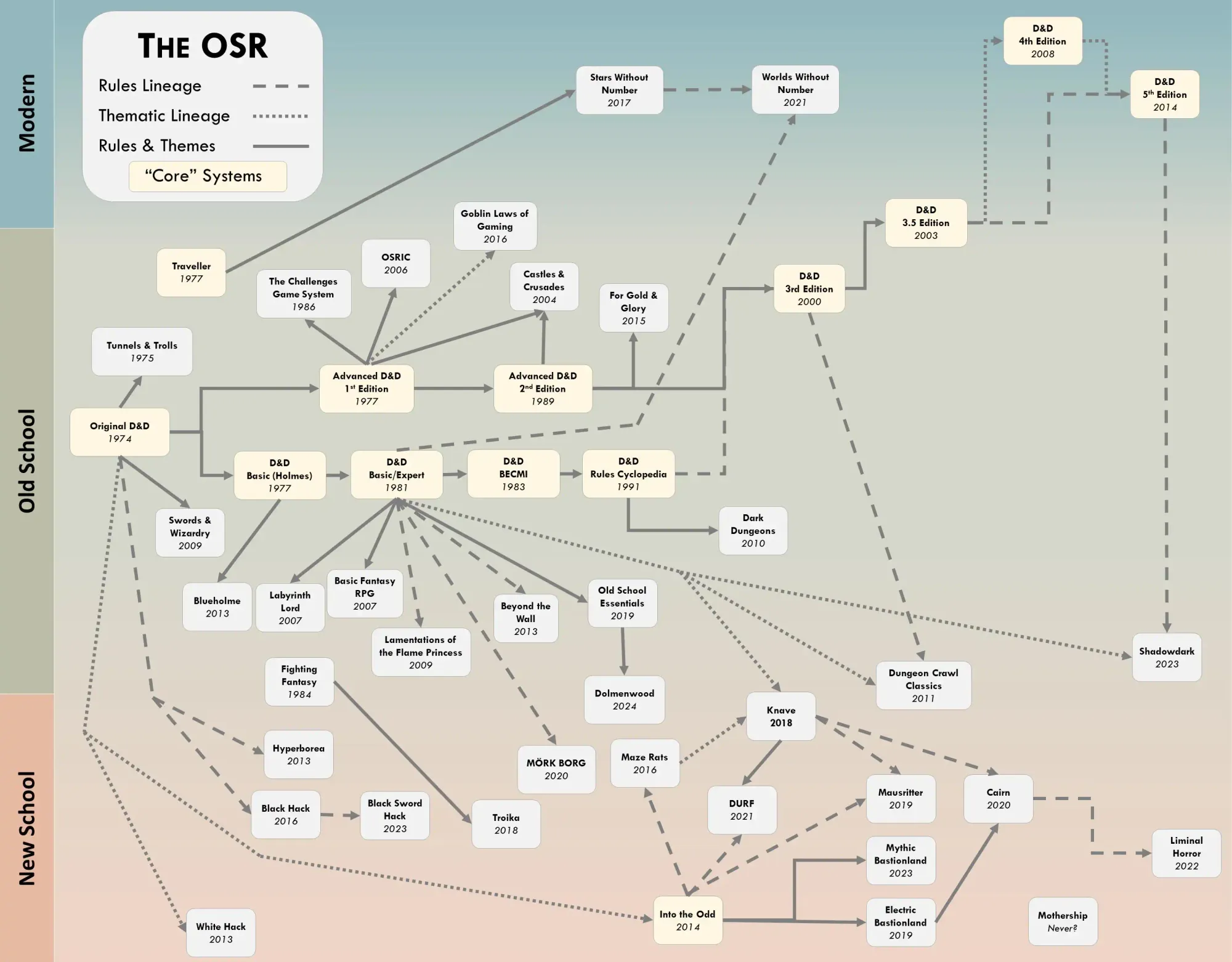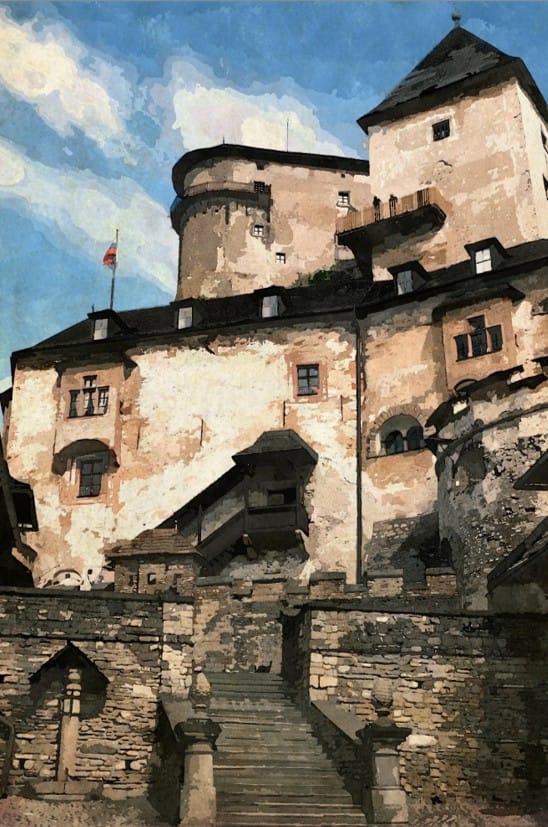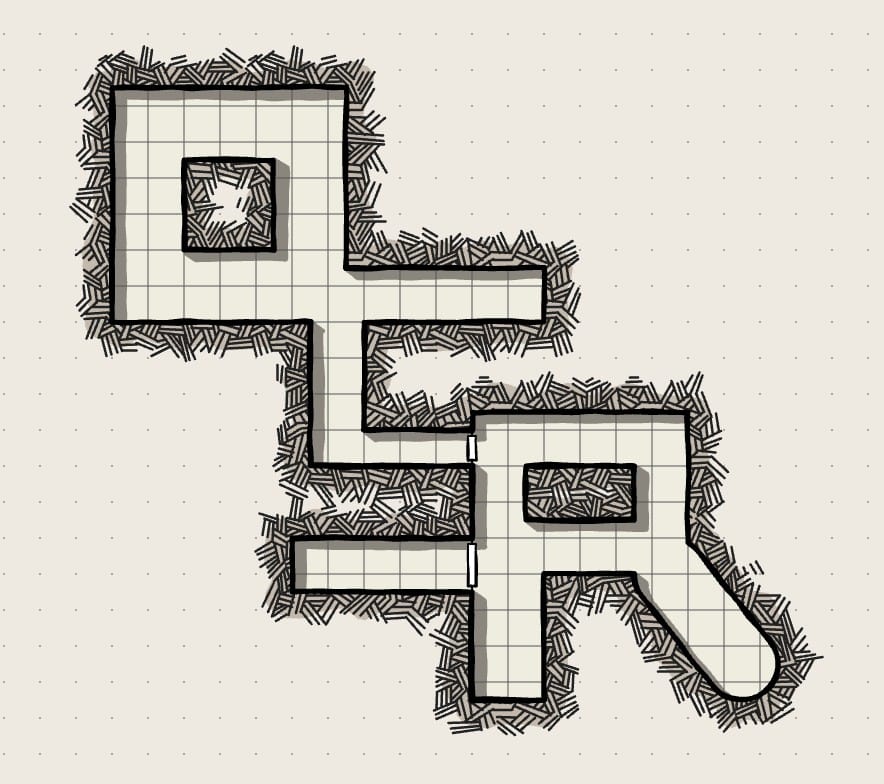As I continue work on Medieval 5e, a working title for now, I’m often asked:
“Is this based on 5e 2024 or 2014 rules?”
The short answer is: it’s rooted in 5e, no question about it. It uses the familiar d20 roll-over system with modifiers and much of the same framework. I’ll be referencing both Creative Commons licenses (2014 and 2024), since I’m drawing inspiration from both.
But there’s also an OSR element to it, if not directly in mechanics, then certainly in tone and play style.
So What Exactly Is OSR?
For those unfamiliar, OSR stands for Old School Renaissance (or sometimes Old School Revival).
Defining it is tricky, there’s no single “official” definition and every GM or player describes it a little differently. But most would agree it represents a movement of passionate fans who love the style of play (not necessarily the rules) of early D&D, before the 3rd Edition era.
There’s a fantastic flowchart that maps this lineage, called the OSR Lineage Chart by Eddy Merkxs. A family tree of D&D and helps show how sprawling and interconnected this scene really is.

Play Style and Tone — Not Just Rules
Here is the key idea: OSR is not defined by its mechanics, it’s defined by how it’s played.
At its heart, there are two main pillars that shape OSR play style:
Rulings, not rules
It’s about the spirit of the game. You’ve probably heard the phrase:
“Rulings, not rules.”
Or, as I like to put it: Rulings over Rules.
In this approach, the Game Master is not just a referee, they are the world’s arbiter. If a rule doesn’t fit the moment, or if no rule exists at all, the GM makes a call that fits the fiction of the world.
Maybe the GM says, “Roll a d6, on a 5 or 6, you succeed.”
No d20s, no modifiers, just a quick, fair ruling that keeps the story moving.
That’s the OSR mindset.
Player Skill, Not Character Abilities
But it’s not just about the GM, the players play differently too.
OSR isn’t a “push-button” style of gaming, You won’t find every answer neatly written on your character sheet. Sure, you might have a class feature or a special ability, but often you won’t, and that’s the fun.
The challenge comes from creative problem-solving, from describing what your character does rather than simply rolling for it. This approach, often called diegetic play, means players describe and declare actions within the fiction of the world, not by invoking a mechanic or rule.
It’s not about ignoring the rules; it’s about using the right rules, the ones that serve the story, the world, and the table.
This philosophy traces straight back to the roots of Free Kriegsspiel, one of the earliest forms of role-playing that inspired modern tabletop games.
(I cover this more deeply in my post on Free Kriegsspiel if you’re curious.)
The bottom line?
OSR play lives on trust, between the players, the GM, and the world they’re building together.
But What About Modern Games?
Many modern games embrace the principles of OSR play while layering on updated mechanics. Shadowdark is one of the best examples, a bridge between old and new. It borrows the smooth, familiar mechanics of 5e but keeps that gritty, minimalist, rulings-not-rules spirit that defines OSR.
Other games, like Mythic Bastionland, Cairn, and 2400 all fit this modern OSR mold, what some now call New School Revival (NSR). Not everyone loves that label, but I use it simply to distinguish that while their mechanics might drift from traditional D&D, their tone and playstyle are very much born from the OSR mindset.
Games like Shadowdark or Cairn build that ethos right into their design. Their rules and mechanics encourage that old-school decision-driven play from the start.
The truth is, you can play any TTRPG in an OSR style, even 5e, if you approach it with that same philosophy: rulings over rules & player skills. The key is setting expectations early so everyone at the table understands the tone and flow you’re aiming for.
Sure, it can be tricky to shift 5e fully into an OSR mindset, some might say at that point you’re just homebrewing or hacking the system.
And that’s fair. But honestly, maybe you like the structure of 5e. Maybe you want a hybrid that blends old-school freedom with modern familiarity. There is no wrong answer here.
The only question that really matters is: Are you having fun?
If yes, then you’re doing it right.
So Where Does Medieval 5e Fit?
In many ways, Medieval 5e sits right in that same hybrid space as Shadowdark, a meeting point between 5e and OSR. A blend of old-school philosophy with modern design clarity.
Shadowdark favors quick character builds and random tables for character advancement, keeping things light and fast. Medieval 5e, on the other hand, gives players more agency in shaping their characters as they grow. Skills and abilities evolve through play, not through chance.
Where Medieval 5e really sets itself apart is in its tone and worldbuilding. It’s grounded. Gritty. Medieval to the core. Humans are the only playable race. Magic is rare, dangerous, sometimes even absent. Combat is deadly, and choices carry weight.
This system is built to tell stories in a low-fantasy, low-magic world where danger, consequence, and human struggle take center stage.

What I’ve tried to create, hopefully with some success, is a game that plays diegetically: one that encourages creative problem-solving, anchored by a familiar mechanical engine that never gets in the way of the story. While giving the GM the liberty to interpret the rules to make rulings, rather than focusing on the rules themselves.
I’m drawing deeply from 5e’s foundation, but my heart has always been with OSR. Maybe it’s nostalgia, I grew up playing D&D Basic/Expert (BX) by Moldvay and Cook, arguably the most influential edition in what became the OSR movement. (One glance at that OSR family tree says it all.)
So yes, Medieval 5e is both modern and old-school.
It’s built for players who love the structure and accessibility of 5e, but crave the creativity, danger, and rulings-first freedom that defined the earliest days of tabletop role-playing.


Member discussion: